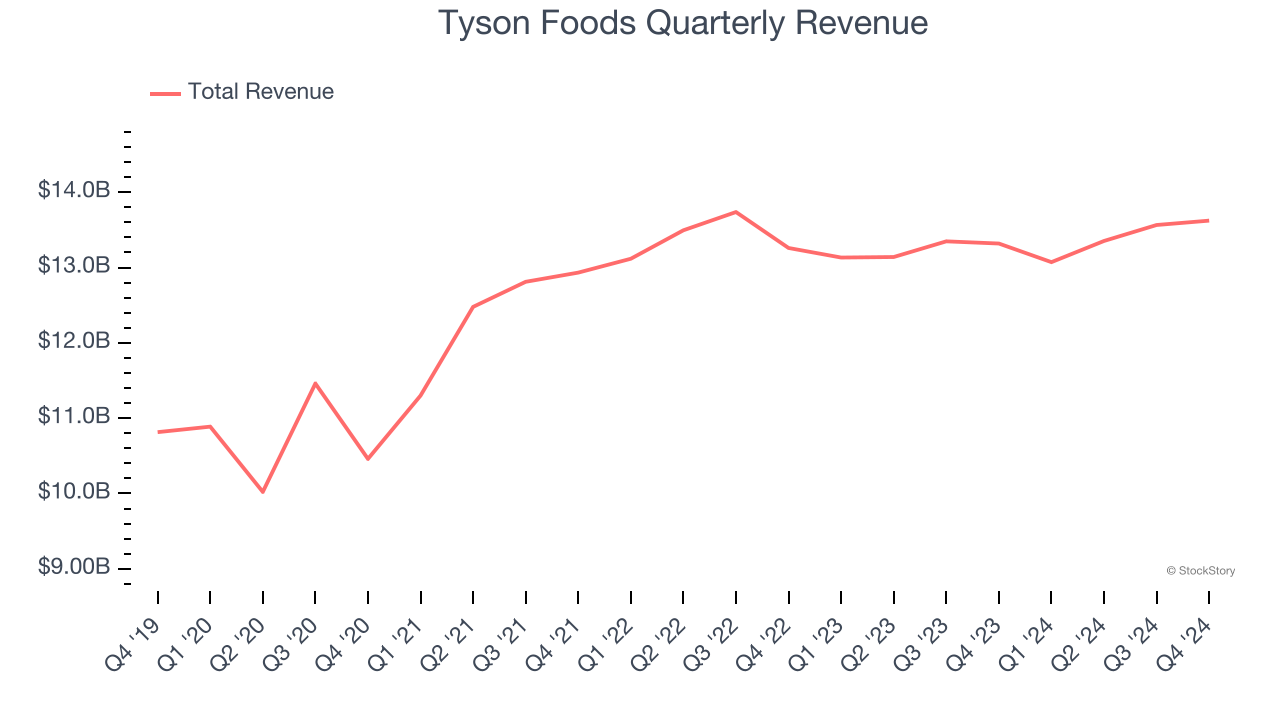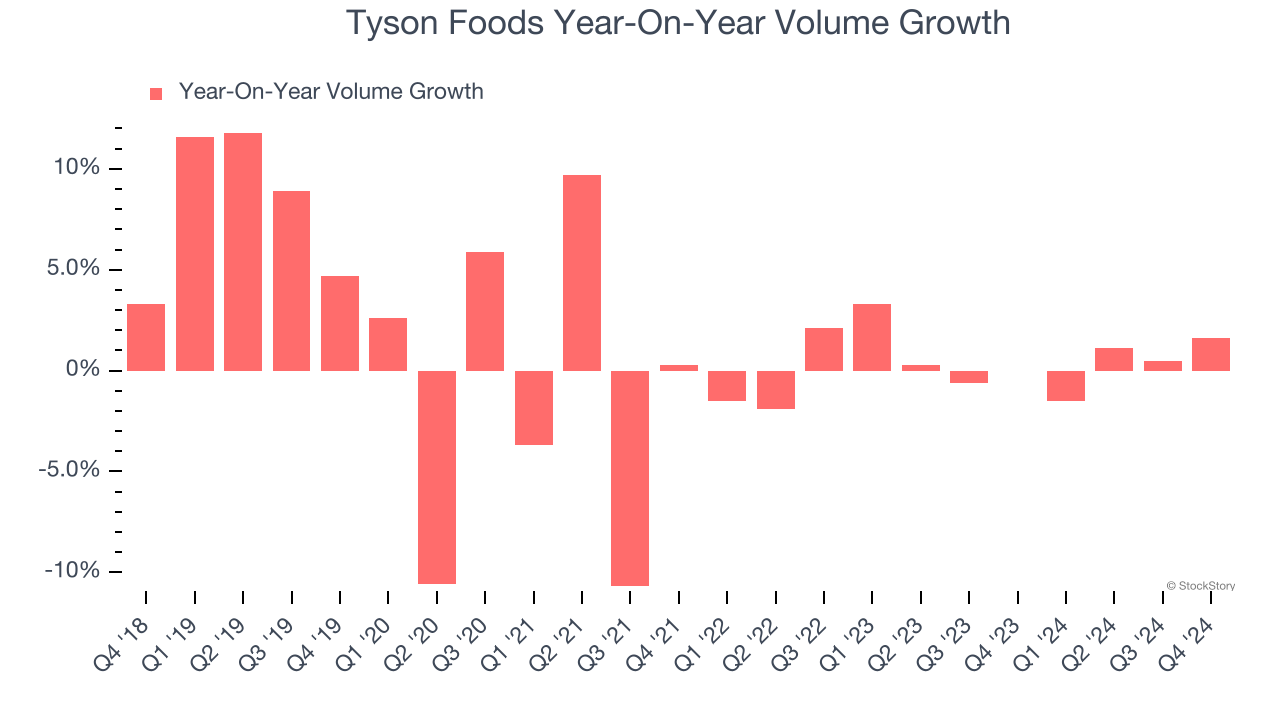
Meat company Tyson Foods (NYSE:TSN) announced better-than-expected revenue in Q4 CY2024, with sales up 2.3% year on year to $13.62 billion. Its non-GAAP profit of $1.14 per share was 29.9% above analysts’ consensus estimates.
Is now the time to buy Tyson Foods? Find out by accessing our full research report, it’s free.
Tyson Foods (TSN) Q4 CY2024 Highlights:
- Revenue: $13.62 billion vs analyst estimates of $13.49 billion (2.3% year-on-year growth, 1% beat)
- Adjusted EPS: $1.14 vs analyst estimates of $0.88 (29.9% beat)
- Adjusted EBITDA: $961 million vs analyst estimates of $848.5 million (7.1% margin, 13.3% beat)
- Operating Margin: 4.3%, up from 1.7% in the same quarter last year
- Free Cash Flow Margin: 5.6%, down from 7.1% in the same quarter last year
- Sales Volumes rose 1.6% year on year (0% in the same quarter last year)
- Market Capitalization: $20.12 billion
"Fiscal year 2025 is off to a strong start, as we delivered our third consecutive quarter of year-over-year growth in sales, operating income, and EPS," said Donnie King, President & CEO of Tyson Foods.
Company Overview
Started as a simple trucking business, Tyson Foods (NYSE:TSN) is one of the world’s largest producers of chicken, beef, and pork.
Perishable Food
The perishable food industry is diverse, encompassing large-scale producers and distributors to specialty and artisanal brands. These companies sell produce, dairy products, meats, and baked goods and have become integral to serving modern American consumers who prioritize freshness, quality, and nutritional value. Investing in perishable food stocks presents both opportunities and challenges. While the perishable nature of products can introduce risks related to supply chain management and shelf life, it also creates a constant demand driven by the necessity for fresh food. Companies that can efficiently manage inventory, distribution, and quality control are well-positioned to thrive in this competitive market. Navigating the perishable food industry requires adherence to strict food safety standards, regulations, and labeling requirements.
Sales Growth
A company’s long-term performance is an indicator of its overall quality. While any business can experience short-term success, top-performing ones enjoy sustained growth for years.
With $53.61 billion in revenue over the past 12 months, Tyson Foods is one of the most widely recognized consumer staples companies. Its influence over consumers gives it negotiating leverage with distributors, enabling it to pick and choose where it sells its products (a luxury many don’t have). However, its scale is a double-edged sword because there are only so many big store chains to sell into, making it harder to find incremental growth. To accelerate sales, Tyson Foods must lean into newer products.
As you can see below, Tyson Foods grew its sales at a sluggish 2.7% compounded annual growth rate over the last three years, but to its credit, consumers bought more of its products.

This quarter, Tyson Foods reported modest year-on-year revenue growth of 2.3% but beat Wall Street’s estimates by 1%.
Looking ahead, sell-side analysts expect revenue to remain flat over the next 12 months, a slight deceleration versus the last three years. This projection is underwhelming and implies its products will face some demand challenges.
Here at StockStory, we certainly understand the potential of thematic investing. Diverse winners from Microsoft (MSFT) to Alphabet (GOOG), Coca-Cola (KO) to Monster Beverage (MNST) could all have been identified as promising growth stories with a megatrend driving the growth. So, in that spirit, we’ve identified a relatively under-the-radar profitable growth stock benefiting from the rise of AI, available to you FREE via this link.
Volume Growth
Revenue growth can be broken down into changes in price and volume (the number of units sold). While both are important, volume is the lifeblood of a successful staples business as there’s a ceiling to what consumers will pay for everyday goods; they can always trade down to non-branded products if the branded versions are too expensive.
Tyson Foods’s quarterly sales volumes have, on average, stayed about the same over the last two years. This stability is normal because the quantity demanded for consumer staples products typically doesn’t see much volatility. 
In Tyson Foods’s Q4 2025, sales volumes jumped 1.6% year on year. This result was an acceleration from its historical levels, certainly a positive signal.
Key Takeaways from Tyson Foods’s Q4 Results
We were impressed by how significantly Tyson Foods blew past analysts’ EBITDA expectations this quarter despite a fairly small revenue beat. We were also glad its EPS outperformed Wall Street’s estimates. On the other hand, its gross margin missed. Zooming out, we think this was a solid quarter. The stock traded up 4.4% to $59 immediately following the results.
Tyson Foods put up rock-solid earnings, but one quarter doesn’t necessarily make the stock a buy. Let’s see if this is a good investment. We think that the latest quarter is only one piece of the longer-term business quality puzzle. Quality, when combined with valuation, can help determine if the stock is a buy. We cover that in our actionable full research report which you can read here, it’s free.














